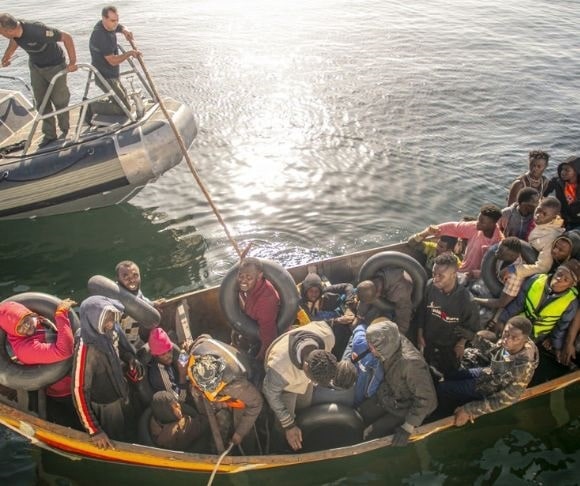The United States isn’t the only country suffering from a surge of illegal immigration at its border, albeit its numbers are higher with millions of migrants crossing into the nation. Still, Europe has been seeing its fair share with an increase of 64% last year, marking a six-year high, with about 330,000 crossings into the European Union (EU).
EU’s Illegal Immigration by the Numbers
 The Central Mediterranean route used to be the most popular way to travel into the EU, but now the Western Balkan migratory route has taken over. In 2022, more than 145,000 illegals were detected in that area, 136% more than the previous year, according to Frontex, the European Border and Coast Guard Agency. This route still saw a lot of action, however, with 102,539 detected migrants trying to reach Italy. This accounted for a 51% increase from 2021, with most immigrants traveling from Bangladesh, Egypt, Syria, and Tunisia.
The Central Mediterranean route used to be the most popular way to travel into the EU, but now the Western Balkan migratory route has taken over. In 2022, more than 145,000 illegals were detected in that area, 136% more than the previous year, according to Frontex, the European Border and Coast Guard Agency. This route still saw a lot of action, however, with 102,539 detected migrants trying to reach Italy. This accounted for a 51% increase from 2021, with most immigrants traveling from Bangladesh, Egypt, Syria, and Tunisia.
The Eastern Mediterranean is a path for those traveling through Turkey into Greece. It was the third-most-common route with nearly 43,000 illegal travelers, mostly Afghans, Congolese, Nigerians, and Syrians. And then there’s the border-free Schengen Area, which gives roughly 400 million EU citizens freedom to enter several countries without passports or checks. The exits from this section saw 71,081 illegal immigration crossings, a 37% increase from 2021.
Unlike the United States, where a lot of children and families make the trek to the border, in the EU, more than 80% were adult men. Frontex reported in a statement, “Women accounted for fewer than one in ten of the detections, while the share of reported minors fell slightly to around 9 percent of all detections.”
While these numbers pale in comparison to the more than two million illegal crossings in America, the statistics account only for illegal immigration, not those seeking asylum. Between January and October 2022, there were nearly 790,000 applicants, EU Agency for Asylum Chief Nina Gregori explained, a 54% increase over the same timeframe in 2021. The numbers also do not account for the protection given to the Ukrainians, either. The EU border agency stressed “the final figures may be higher due to delayed reporting,” and Gregori, in December, said, “It’s pretty clear that the growing number of applications will continue for the foreseeable future,” with more than 100,000 per month late last year.
What Is Causing Such a Migrant Surge?
In January 2022, the International Centre for Migration Policy Development said the rise in irregular migration was caused by a few key factors, including crises at the border and key elections. Of particular note was Afghanistan, for which many lay the blame at President Joe Biden’s feet for his messy withdrawal of troops that left thousands of Afghan allies trapped. The agency said:
“The main drivers behind the spike in overall numbers were conflict and economic imbalances. The Taliban takeover of Afghanistan displaced over 670,000 Afghans, and initial estimates predict a further 500,000 will flee the country.”

(Photo by Yassine Gaidi/Anadolu Agency via Getty Images)
Of course, the Russia-Ukraine war has only added to the immigration issue with so many Ukrainians seeking refuge while President Vladimir Putin continues his onslaught on the smaller country. Adding to the migrant woes is Croatia’s membership in the Schengen Area, which started Jan. 1 of this year. As ZeroHedge pointed out, this “will inevitably lead to greater challenges in this region, extending the length of the EU’s external border considerably.”
This area gives people the freedom to travel without pesky border checks. “Free movement of persons enables every EU citizen to travel, work and live in an EU country without special formalities,” the European Commission explained. “Schengen underpins this freedom by enabling citizens to move around the Schengen Area without being subject to border checks.” Most of the EU countries are part of this area except for Bulgaria, Cyprus, Ireland, and Romania. However, Bulgaria and Romania are currently in the process of joining, the agency said. Iceland, Norway, Liechtenstein, and Switzerland, non-EU states, have also joined.
The European Commission is working on a strategy to strengthen the border and manage migration routes to help ease the influx of illegal immigrants. Some of the projects include utilizing more technology, such as the Visa Information System and biometric features for identification. And yet, as with the United States, it seems that political will remains the most significant stumbling block to ending the ongoing migrant crisis.




